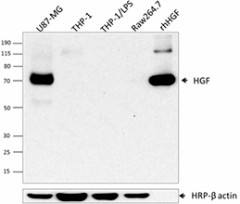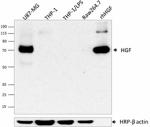- Clone
- A15061E (See other available formats)
- Regulatory Status
- RUO
- Other Names
- Hepatocyte Growth Factor, Scatter Factor (SF), Hepatopoietin (HPTA), Lung fibroblast-derived mitogen
- Isotype
- Mouse IgG2b, κ
- Ave. Rating
- Submit a Review
- Product Citations
- publications

-

Total cell lysates (30 µg protein) from U87-MG (lane 1), THP-1 untreated (lane 2), THP-1 treated with PMA for three days and LPS for one day (lane 3), Raw264.7 (lane 4) and 5 ng recombinant human HGF (lane 5) were resolved by 4-12% Bis-Tris gel electrophoresis under non-reducing condition, transferred to nitrocellulose, and probed with purified anti-HGF (clone A15061E) antibody. Proteins were visualized using a goat anti-mouse-IgG secondary antibody conjugated to HRP and chemiluminescence detection. Direct-Blot™ HRP anti-β-actin (clone 2F1-1) antibody was used as a loading control. -

Whole cell extracts (15 µg total protein) of indicated cell lines, reduced or non-reduced with βME, were resolved by 4-12% Bis-Tris gel electrophoresis, transferred to a PVDF membrane, and probed with 0.5 mg/mL of purified anti-HGF antibody (clone A15061E) overnight at 4°C. Proteins were visualized by chemiluminescence detection using HRP goat anti-mouse IgG antibody (Cat. No. 405306) at a 1:3000 dilution. Direct-Blot™ HRP anti-β-actin (clone 2F1-1) antibody was used as a loading control at a 1:10000 dilution (lower). Lane M: Molecular weight marker.
HGF (Hepatocyte growth factor) is a multifunctional cytokine that plays important roles in cell proliferation, survival, motility and morphogenesis. HGF protects the epithelium, neurons and cardiomyocytes during organ diseases; this protective effect is mediated through anti-apoptotic signals via inhibition of caspase-3 activity or induction of anti-apoptotic molecules. Secreted by cells of mesenchymal origin, HGF is the specific ligand for the tyrosine-kinase receptor c-MET (cellular mesenchymal-epithelial transition), also called MET, which is expressed in different types of epithelial, endothelial and hematopoietic progenitor cells. Aberrantly activated MET/HGF signaling correlates with tumorigenesis and metastasis, and is regarded as a target for novel anti-cancer treatments.
Product DetailsProduct Details
- Verified Reactivity
- Human
- Antibody Type
- Monoclonal
- Host Species
- Mouse
- Immunogen
- Recombinant Human HGF (carrier-free)
- Formulation
- Phosphate-buffered solution, pH 7.2, containing 0.09% sodium azide.
- Preparation
- The antibody was purified by affinity chromatography.
- Concentration
- 0.5 mg/ml
- Storage & Handling
- The antibody solution should be stored undiluted between 2°C and 8°C.
- Application
-
WB - Quality tested
- Recommended Usage
-
Each lot of this antibody is quality control tested by Western blotting. For Western blotting, the suggested use of this reagent is 0.5 - 2.0 µg per mL. It is recommended that the reagent be titrated for optimal performance for each application.
- Application Notes
-
This antibody works for Western blotting under non-reducing conditions only and does not cross-react with mouse.
- RRID
-
AB_2632766 (BioLegend Cat. No. 692602)
Antigen Details
- Structure
- Heterodimer (alpha and beta chains). Pro-HGF has 728 amino acids, the predicted molecular weight is approximately 83 kD. The alpha and beta chains contain 463 and 234 amino acids and have a predicted molecular mass of approximately 53.6 and 26 kD respec
- Distribution
-
Mesenchymal cells, liver sinusoidal endothelial, and macrophages.
- Function
- Stimulates epithelial cell proliferation, motility, morphogenesis and angiogenesis. Hypoxia and hyperglycemia suppress HGF production. Also, TGF-β and angiotensin-II depress HGF production in vitro.
- Interaction
- Hepathocytes and epithelial cells.
- Ligand/Receptor
- MET receptor.
- Biology Area
- Angiogenesis, Apoptosis/Tumor Suppressors/Cell Death, Cancer Biomarkers, Cell Biology, Cell Proliferation and Viability, Immunology, Signal Transduction
- Molecular Family
- Cytokines/Chemokines, Growth Factors
- Antigen References
-
1. Hartmann S, et al. 2016. Clin. Cancer Res. 22:4005.
2. Fajardo-Puerta AB, et al. 2016. J. Clin. Pathol. 69:575.
3. Zhang Y, et al. 2016. Oncotarget. 7:37370-89.
4. Frisch RN, et al. 2016. Expert Opin. Ther. Targets 20:1087.
5. Kataoka H, et al. 2000. J. Biol. Chem. 275:40453.
6. Wang X, et al. 2002. Mol. Cell. 9:411.
7. Wu MH, et al. 2004. Gene Ther. 11:170.
8. Mizuno S, et al. 2008. Front. Biosci. 13:7072.
9. D'Angelo F, et al. 2013. Clin. Exp. Immunol. 174:60. - Gene ID
- 3082 View all products for this Gene ID
- UniProt
- View information about HGF on UniProt.org
Related Pages & Pathways
Pages
Other Formats
View All HGF Reagents Request Custom Conjugation| Description | Clone | Applications |
|---|---|---|
| Purified anti-HGF | A15061E | WB |
Compare Data Across All Formats
This data display is provided for general comparisons between formats.
Your actual data may vary due to variations in samples, target cells, instruments and their settings, staining conditions, and other factors.
If you need assistance with selecting the best format contact our expert technical support team.










Follow Us